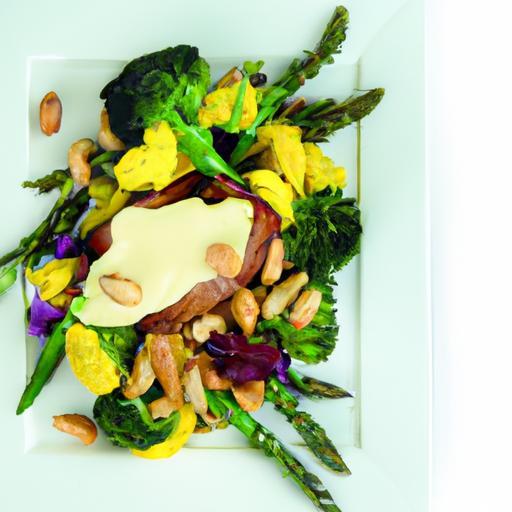Beneath the canopy of whispering leaves and amidst the gentle rustle of wild bushes lies a hidden world brimming with nature’s most delightful offerings-an art waiting to be rediscovered. Foraging, the timeless practice of gathering edible treasures from the wild, invites us to embark on a sensory journey where curiosity leads the way and every step uncovers a delicious secret. In “The Art of Foraging: Discovering Nature’s Nutty Treasures,” we delve into the fascinating realm of wild nuts-those crunchy gems tucked away in forests and fields-that have fueled humanity through the ages. Join us as we explore the techniques, traditions, and tales behind these nourishing finds, unlocking the ancient connection between people and the earth’s abundant bounty.
The Art of Foraging: Discovering Nature’s Nutty Treasures
The art of foraging: discovering nature’s nutty treasures invites you into an enchanting journey where wild edible nuts transform simple walks into epic culinary adventures. Imagine cracking open freshly harvested chestnuts, hazelnuts, or walnuts, their woodsy aroma filling the air and hinting at flavors that have been nurtured by the earth and sun. This recipe celebrates the magic of wild nuts, embracing the seasonal timing, sustainable gathering, and versatile uses that keep their natural goodness alive in your kitchen year-round.
Prep and Cook Time
Preparation: 20 minutes
Cooking: 35 minutes
Total Time: 55 minutes
Yield
Serves 6 as a delightful snack or appetizer
Difficulty Level
Medium – ideal for curious foragers and adventurous cooks
Ingredients
- 2 cups freshly foraged or store-bought wild hazelnuts, shelled and rinsed
- 1 cup wild chestnuts, scored and roasted
- 1/2 cup finely chopped wild walnuts
- 3 tbsp raw honey or maple syrup
- 2 tbsp extra virgin olive oil
- 1 tsp smoked sea salt
- 1/2 tsp freshly ground black pepper
- 1 tbsp fresh rosemary, finely chopped
- 1 clove garlic, minced
- Juice of 1/2 lemon
- Optional garnish: toasted wild pine nut kernels or edible flowers
Instructions
- Roast and prepare the nuts: Begin by roasting the wild hazelnuts and walnuts separately in a preheated oven at 350°F (175°C) for about 10 minutes, until fragrant and lightly browned. Stir halfway through to ensure even roasting.
- Chestnut preparation: Score the chestnuts with a sharp knife (an X on the flat side), then roast them for 25 minutes. Once cool, peel off the shells carefully to reveal the tender flesh inside.
- Mix the glaze: In a bowl, whisk together honey or maple syrup, olive oil, smoked sea salt, black pepper, minced garlic, lemon juice, and rosemary until well combined. This glaze will enhance the nuts’ natural flavors with a subtle sweet and smoky note.
- Combine nuts with glaze: Toss all the roasted nuts gently in the glaze, ensuring they are evenly coated. Allow the mixture to marinate for 10 minutes at room temperature so the flavors meld beautifully.
- Final toasting: Spread the glazed nuts on a parchment-lined baking sheet and return to the oven for 5-7 minutes at 325°F (160°C). Keep a close eye to prevent burning; stir occasionally. This step caramelizes the glaze and adds a crunchy finish.
- Cool and serve: Remove from oven and let cool completely. Transfer to a serving bowl and garnish with toasted pine nuts or edible flowers for an elegant touch.
Tips for Success
- Substitutions: If wild nuts aren’t accessible, high-quality locally sourced nuts will also work beautifully.
- Harvest timing: For best flavor and nutrition, gather nuts in early autumn when they’ve naturally ripened and begun to drop.
- Gluten-free and vegan friendly: This recipe is naturally gluten-free and vegan, but always double-check your maple syrup source for purity.
- Storage: Store cooled glazed nuts in an airtight container at room temperature for up to two weeks to savor the natural crunch.
- Wild nut sourcing: Always forage sustainably-take only what you will use and avoid disturbing the natural habitat.
Serving Suggestions
Present these toasted wild nuts on a rustic wooden board alongside aged cheeses, fresh fruit slices like pears or apples, and a drizzle of extra honey. They also pair wonderfully with a robust glass of red wine or spicy herbal teas. For a festive flair, toss them into wild green salads or sprinkle over roasted vegetables to add a satisfying crunch and depth of flavor.
| Nutrient | Per Serving |
|---|---|
| Calories | 210 kcal |
| Protein | 5 g |
| Carbohydrates | 15 g |
| Fat | 17 g |

Explore more about sustainable wild food foraging and seasonal recipes in our Wild Food Foraging Guide. To deepen your foraging knowledge, visit U.S. Forest Service Trees and Wildlife.
Q&A
Q: What is foraging, and why has it become popular recently?
A: Foraging is the age-old practice of searching for and gathering wild edible plants and nuts directly from nature. Recently, it’s gained popularity as people seek healthier lifestyles, reconnect with the outdoors, and embrace sustainable eating. It’s like uncovering hidden treasures that nature generously offers-often with a delicious, nutty surprise.
Q: Why focus on nuts in the art of foraging?
A: Nuts are nature’s nutritious gems-packed with healthy fats, proteins, and essential nutrients. They’re also incredibly versatile, adding crunch and flavor to meals. Foraging nuts brings a tactile excitement: cracking open shells, identifying species, and savoring the earthy taste of something truly wild.
Q: Which nuts are commonly foraged, and where might you find them?
A: Commonly foraged nuts include walnuts, hazelnuts, chestnuts, acorns, and pecans. These treasures thrive in various habitats-from dense forests and woodlands to parklands and even some urban edges. Knowing your local landscape and seasonal timing is key to a successful haul.
Q: How do you safely identify edible nuts in the wild?
A: Safety starts with education-use a reliable field guide or join an expert-led walk. Check for distinctive leaf shapes, bark textures, and shell characteristics. For instance, chestnuts have prickly husks, while hazelnuts grow inside smooth, round shells. Avoid anything uncertain; nature’s bounty is generous but respects boundaries.
Q: What’s the best way to harvest nuts without harming the environment?
A: Ethical foraging is about respect. Only take what you need-leaving plenty for wildlife and future growth. Use gentle harvesting techniques to avoid damaging trees and plants. Remember, you’re a guest in their habitat, invited to share in the season’s gifts without spoiling it.
Q: How can you prepare wild nuts once they’re gathered?
A: Once you’ve gathered your nutty treasures, they can be roasted, ground into flours, added to salads, or made into creamy butters. Some nuts, like acorns, require processing to remove bitterness-usually by leaching tannins in water. Experimenting with recipes can be a joyful extension of your foraging adventure.
Q: What are some creative ways to incorporate foraged nuts into everyday meals?
A: Sprinkle toasted walnuts on morning oatmeal, stir minced hazelnuts into homemade chocolate spreads, or toss chestnuts into hearty stews. Nut oils from wild varieties can also add unique flavors to dressings. With foraged nuts, you’re infusing your food with the story of the wild.
Q: Can foraging nuts be a year-round activity?
A: Nuts are mostly seasonal, typically harvested in late summer through fall when they mature and drop. However, some nuts like beechnuts have more limited windows. Using seasonal calendars helps plan your foraging outings, turning it into a rhythmic celebration of nature’s cycles.
Q: What role does foraging play in connecting people to nature and culture?
A: Foraging reawakens a primal link between humans and their environment. It’s a dance of observation, patience, and discovery-breaking the barrier between wilderness and pantry. Culturally, many traditions revolve around foraging, turning it into a shared history and a sustainable future woven from the forest floor.
Q: How can beginners start their own journey into the art of foraging nuts?
A: Start small: learn from books, apps, or local foraging groups. Begin with easily identifiable nuts and safe areas. Patience and respect are your best tools. Soon, you’ll find that each foraging trip is a step deeper into a natural world brimming with nutty, nourishing treasures waiting to be discovered.
Wrapping Up
As the sun dips below the horizon and the forest floor grows quiet, the art of foraging reveals itself not just as a means to gather nature’s bounty, but as a timeless dance between curiosity and respect. Each nut cracked open, each seed gathered, tells a story of seasons past and the subtle rhythms of the wild. By embracing the treasures hidden within leaves and loam, we reconnect with the earth in a way that feeds both body and soul. So next time you wander beneath towering trees or along a whispering creek, remember: the humble nut you find may be a key to unlocking nature’s oldest, sweetest secrets. Happy foraging, and may your discoveries be as rich as the forests that cradle them.


